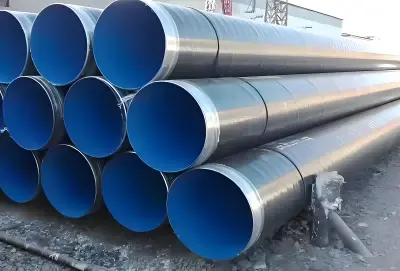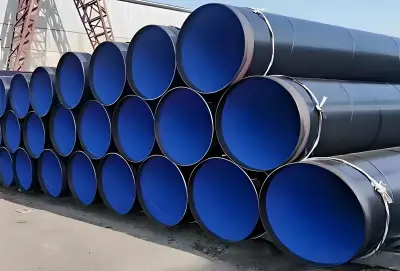When it comes to protecting steel pipes from corrosion, two popular methods stand out: PE tape wrapping and extrusion coating. Both techniques involve applying polyethylene (PE) to create a protective barrier, but they differ significantly in their application processes and outcomes. PE coated steel pipes are crucial for various industries, including oil and gas transportation, water supply systems, and offshore platform construction. Understanding the distinctions between these methods is essential for project managers and engineers to make informed decisions about pipeline protection.
|
|
|
PE tape wrapping: Advantages and limitations
Cost-effective solution for smaller projects
PE tape wrapping has long been a go-to method for protecting steel pipes, particularly in smaller-scale projects. This technique involves manually applying layers of polyethylene tape around the pipe surface. The process is relatively straightforward and requires minimal specialized equipment, making it an attractive option for budget-conscious projects.
One of the primary advantages of PE tape wrapping is its cost-effectiveness for shorter pipeline segments or repair work. The materials are readily available, and the application process can be carried out on-site with minimal training. This flexibility makes it an excellent choice for quick repairs or projects with limited access to advanced coating facilities.
Flexibility in application and maintenance
Another benefit of PE coated steel pipe tape wrapping is its versatility in application. The tape can be applied to pipes of various diameters and shapes, making it suitable for complex pipeline systems. Additionally, the wrapped pipes can be easily transported and installed without risking damage to the protective coating.
Maintenance of PE tape-wrapped pipes is relatively straightforward. In case of localized damage, sections of the tape can be replaced without the need for extensive equipment or specialized skills. This ease of repair contributes to lower long-term maintenance costs, especially for pipelines in remote or challenging locations.
Potential gaps in coverage and durability concerns
Despite its advantages, PE tape wrapping has some limitations that project managers should consider. The manual application process can lead to inconsistencies in coverage, potentially leaving small gaps or overlaps in the protective layer. These imperfections may create weak points in the coating, exposing the underlying steel to corrosive elements over time.
Durability is another concern with tape-wrapped pipes. The multiple layers of tape can be prone to separation or disbondment, especially in harsh environmental conditions or when subjected to significant temperature fluctuations. This vulnerability may lead to reduced service life and increased maintenance requirements compared to other coating methods.
Extrusion coating: Enhancing pipe protection
Superior corrosion resistance for PE coated steel pipesExtrusion coating represents a significant advancement in pipe protection technology. This method involves applying molten polyethylene directly onto the steel pipe surface using specialized equipment. The result is a seamless, uniform coating that adheres tightly to the pipe, providing superior corrosion resistance.
The extrusion process creates a strong molecular bond between the PE coated steel pipe and the steel surface, dramatically reducing the risk of coating separation or disbondment. This enhanced adhesion translates to better protection against moisture, chemicals, and abrasive soil conditions, making extrusion-coated pipes ideal for demanding applications in the oil and gas industry.
Seamless coverage and improved longevity
One of the key advantages of extrusion coating is the seamless coverage it provides. Unlike tape wrapping, which may have small gaps or overlaps, the extruded PE forms a continuous, uniform layer around the entire pipe surface. This seamless protection eliminates weak points and potential entry points for corrosive agents, significantly extending the service life of the pipeline.
The improved longevity of extrusion-coated pipes translates to reduced maintenance requirements and lower lifecycle costs. This is particularly beneficial for large-scale projects or pipelines in challenging environments, where frequent maintenance or replacement can be extremely costly and disruptive.
Advanced 3LPE technology for optimal performance
The extrusion coating method has paved the way for advanced technologies like Three-Layer Polyethylene (3LPE) coating. This cutting-edge system combines an epoxy primer, adhesive layer, and extruded PE top coat to create an exceptionally durable and high-performance protective barrier.
3LPE coating offers unparalleled corrosion resistance, mechanical strength, and thermal stability. It's particularly well-suited for high-pressure pipelines, offshore installations, and projects in extreme climates. The multi-layer structure provides redundant protection, ensuring that even if one layer is compromised, the underlying layers continue to safeguard the steel pipe.
Choosing the right method for your project
Evaluating project scale and environmental factorsWhen deciding between PE tape wrapping and extrusion coating, project scale is a crucial consideration. For smaller projects or short pipeline segments, the cost-effectiveness and simplicity of tape wrapping may be advantageous. However, for large-scale installations or projects with high-performance requirements, the superior protection and longevity of extrusion coating often justify the higher initial investment.
Environmental factors play a significant role in the selection process. In areas with aggressive soil conditions, extreme temperatures, or high moisture levels, the seamless coverage and enhanced durability of extrusion-coated pipes offer better long-term protection. Conversely, in less challenging environments or for temporary installations, tape wrapping may provide adequate protection at a lower cost.
Comparing long-term costs and maintenance requirements
While PE tape wrapping may have lower upfront costs, it's essential to consider the long-term expenses associated with each method. Extrusion-coated pipes typically require less frequent maintenance and have a longer service life, potentially offsetting the higher initial investment over time.
Maintenance requirements also differ between the two methods. Tape-wrapped pipes may need more frequent inspections and repairs, especially in demanding environments. In contrast, extrusion-coated pipes, particularly those with 3LPE technology, offer more reliable protection with minimal maintenance needs, reducing operational costs and downtime.
Industry-specific considerations for oil and gas pipelines
In the oil and gas industry, where pipeline integrity is paramount, extrusion coating is often the preferred choice. The high-pressure conditions, potential exposure to corrosive substances, and strict regulatory requirements in this sector demand the highest level of protection that extrusion coating can provide.
For offshore platforms and subsea pipelines, the superior mechanical strength and excellent adhesion of extrusion-coated pipes are particularly beneficial. These properties help withstand the pressures of deep-water environments and resist damage during installation and operation.
Both PE tape wrapping and extrusion coating methods have their place in pipeline protection. Tape wrapping offers cost-effective solutions for smaller projects and easy maintenance, while extrusion coating provides superior long-term protection and performance, especially for large-scale and demanding applications. By carefully evaluating project requirements, environmental factors, and long-term costs, project managers and engineers can make informed decisions to ensure the longevity and reliability of their pipeline infrastructure. As technology continues to advance, extrusion coating, particularly PE coated steel pipe systems, is setting new standards for pipeline protection in challenging environments and critical industries.
PE Coated Steel Pipe Supplier
Hebei Longma Group stands out as a leading supplier of high-quality PE coated steel pipes. Our state-of-the-art production facility boasts advanced equipment imported from Germany, complemented by four independently developed production lines. With a team of over 300 skilled employees, including 60+ technical experts and a dedicated equipment research team, we ensure top-notch quality and innovation in every product.
Our comprehensive testing facilities, including online ultrasonic automatic flaw detectors and industrial X-ray television, guarantee the highest standards of quality control. We pride ourselves on rapid delivery, with the capability to produce standard thickness steel pipes in as little as 7 days. Our certifications, including API 5L, ISO 9001, ISO 14001, FPC, and Environmental Quality System, underscore our commitment to excellence and compliance with international standards.
Hebei Longma Group offers competitive pricing thanks to our long-standing relationships with raw material suppliers, efficient production facilities, and stringent quality control systems. Our steel pipes meet various standards, including API 5L, ASTM A53, EN10210, and AS/NZS 1163, with coating options conforming to DIN 30670, DIN30678, CSAZ245.20, EN10339, ISO21809-1, AWWAC210, and C213. Available in outer diameters ranging from 60.3mm to 1422mm and wall thicknesses from 6.02mm to 50.8mm, our products cater to diverse project requirements. For inquiries or to discuss your specific needs, contact us at info@longma-group.com.














